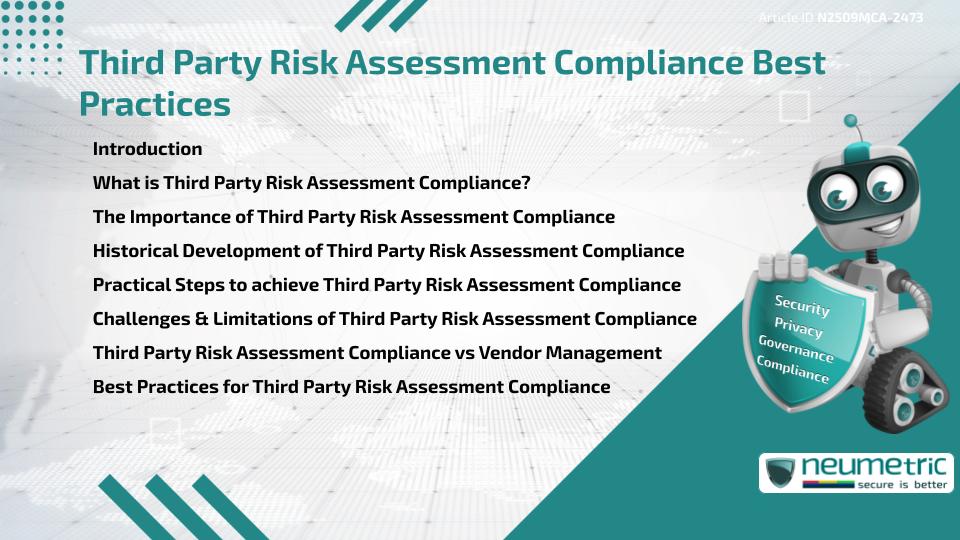Table of Contents
ToggleIntroduction
Third Party Risk Assessment Compliance is the structured process of evaluating & managing Risks that arise when organisations work with Vendors, Contractors or Service Providers, while ensuring alignment with Regulatory Standards. It addresses Cybersecurity, Financial, Legal & Reputational Risks linked to external Partners. Effective Third Party Risk Assessment Compliance helps organisations prevent breaches, avoid fines & maintain trust. This article explores its meaning, importance, history, practical steps, challenges, comparisons & Best Practices.
What is Third Party Risk Assessment Compliance?
Third Party Risk Assessment Compliance is the integration of Risk evaluation processes into an organisation’s Compliance Framework. It ensures that Vendors & Partners meet Security, Privacy & Operational standards. Much like inspecting food suppliers before stocking a restaurant, organisations must verify their Vendors’ reliability to ensure Business Continuity & Regulatory alignment.
The Importance of Third Party Risk Assessment Compliance
Third Party Risk Assessment Compliance is essential for several reasons:
- Data Security: Protects sensitive Customer & Organisational data shared with Vendors.
- Regulatory Alignment: Ensures Compliance with frameworks like GDPR, HIPAA & PCI DSS.
- Reputation Management: Demonstrates diligence in Vendor oversight to Clients & Regulators.
- Business Continuity: Prevents supply chain disruptions due to Vendor weaknesses.
Without Third Party Risk Assessment Compliance, organisations expose themselves to hidden Vulnerabilities in their supply chains.
Historical Development of Third Party Risk Assessment Compliance
Vendor-related Risks gained attention in the late twentieth century as global supply chains became more interconnected. Early Compliance frameworks in Financial services required organisations to review outsourcing Risks. With the rise of digital transformation & cloud services, regulations expanded across industries to cover Third Party Cybersecurity Risks.
Authorities like NIST & the European Union Agency for Cybersecurity [ENISA] developed guidelines, cementing Third Party Risk Assessment Compliance as a Regulatory requirement.
Practical Steps to achieve Third Party Risk Assessment Compliance
Organisations can achieve Third Party Risk Assessment Compliance through the following steps:
- Due Diligence: Evaluate Vendors before onboarding, checking Financial Health & Security Posture.
- Contracts & SLAs: Include Compliance clauses, performance standards & Audit rights.
- Ongoing Monitoring: Continuously assess Vendor Risks, not just at onboarding.
- Risk Scoring: Use metrics to classify Vendors by Risk level.
- Documentation: Maintain Audit-ready Records of Assessments & decisions.
Challenges & Limitations of Third Party Risk Assessment Compliance
While effective, Third Party Risk Assessment Compliance faces challenges:
- Complex Vendor Ecosystems: Large organisations may manage hundreds of third parties.
- Resource Constraints: Smaller organisations may lack tools for Continuous Monitoring.
- Dynamic Risks: Vendor Risks change over time, requiring frequent reassessments.
- Data Transparency: Vendors may hesitate to disclose full security details.
These challenges highlight the importance of structured, scalable Compliance programs.
Third Party Risk Assessment Compliance vs Vendor Management
Vendor management ensures contractual obligations & operational efficiency. Third Party Risk Assessment Compliance, however, focuses on Regulatory alignment & Risk minimisation. To compare, Vendor management is like managing a sports team’s logistics, while Third Party Risk Assessment Compliance is like checking every player’s fitness to ensure Compliance with competition rules.
Best Practices for Third Party Risk Assessment Compliance
To sustain Third Party Risk Assessment Compliance, organisations should:
- Categorise Vendors by criticality & Risk exposure.
- Automate monitoring with Compliance software.
- Require third parties to adopt frameworks like ISO 27001.
- Conduct regular Compliance training for Procurement & Risk teams.
- Engage independent Auditors for high-Risk Vendors.
These Best Practices ensure Compliance becomes a continuous & collaborative effort.
Conclusion
Third Party Risk Assessment Compliance is essential for managing vendor-related Risks & meeting Regulatory requirements. By conducting Due diligence, monitoring Vendors & applying Best Practices, organisations strengthen their resilience against data breaches, supply chain disruptions & reputational harm.
Takeaways
- Third Party Risk Assessment Compliance safeguards data & strengthens Regulatory alignment.
- It developed alongside global supply chains & digital transformation.
- Practical steps include due diligence, monitoring & documentation.
- Challenges include complexity, resource constraints & Vendor transparency.
- Best Practices create a culture of Accountability & Resilience.
FAQ
What is Third Party Risk Assessment Compliance?
It is the process of evaluating & managing Vendor Risks within Compliance frameworks.
Why is Third Party Risk Assessment Compliance important?
It protects data, ensures regulatory alignment & prevents supply chain disruptions.
What are the main steps in Third Party Risk Assessment Compliance?
The steps include Due diligence, contracts, monitoring, Risk scoring & documentation.
How does Third Party Risk Assessment Compliance differ from vendor management?
Vendor management focuses on efficiency, while Compliance emphasises Risk reduction & Regulatory adherence.
What challenges exist in Third Party Risk Assessment Compliance?
Challenges include large Vendor ecosystems, resource limitations & lack of transparency.
Can small organisations implement Third Party Risk Assessment Compliance?
Yes, by prioritising high-Risk Vendors & adopting affordable Monitoring Tools.
How often should vendors be reassessed for Compliance?
Vendors should be reassessed annually or after significant changes in services or Risks.
What frameworks support Third Party Risk Assessment Compliance?
Frameworks include ISO 27001, NIST guidelines & ENISA recommendations.
Need help for Security, Privacy, Governance & VAPT?
Neumetric provides organisations the necessary help to achieve their Cybersecurity, Compliance, Governance, Privacy, Certifications & Pentesting needs.
Organisations & Businesses, specifically those which provide SaaS & AI Solutions in the Fintech, BFSI & other regulated sectors, usually need a Cybersecurity Partner for meeting & maintaining the ongoing Security & Privacy needs & requirements of their Enterprise Clients & Privacy conscious Customers.
SOC 2, ISO 27001, ISO 42001, NIST, HIPAA, HECVAT, EU GDPR are some of the Frameworks that are served by Fusion – a SaaS, multimodular, multitenant, centralised, automated, Cybersecurity & Compliance Management system.
Neumetric also provides Expert Services for technical security which covers VAPT for Web Applications, APIs, iOS & Android Mobile Apps, Security Testing for AWS & other Cloud Environments & Cloud Infrastructure & other similar scopes.
Reach out to us by Email or filling out the Contact Form…


